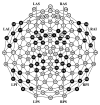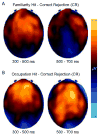The FN400 indexes familiarity-based recognition of faces
- PMID: 17258471
- PMCID: PMC1948028
- DOI: 10.1016/j.neuroimage.2006.12.016
The FN400 indexes familiarity-based recognition of faces
Abstract
Separate event-related brain potential (ERP) components have been hypothesized to index familiarity and recollection processes that support recognition memory. A 300- to 500-ms mid-frontal FN400 old/new difference has been related to familiarity, whereas a 500- to 800-ms parietal old/new difference has been related to recollection. Other recent work has cast doubt on the FN400 familiarity hypothesis, especially its application to familiarity-based recognition of conceptually impoverished stimuli such as novel faces. Here we show that FN400 old/new differences can be observed with novel faces, and as predicted by the familiarity hypothesis, these differences are observed regardless of whether or not recognition is accompanied by the recollection of specific details from the study episode. Furthermore, FN400 differentiation between hits and misses is more consistent with an explicit familiarity process than an implicit memory process.
Figures




Comment in
-
Potential (ERP) studies of recognition memory for faces.Neuroimage. 2007 Jun;36(2):488-9. doi: 10.1016/j.neuroimage.2006.12.049. Epub 2007 May 3. Neuroimage. 2007. PMID: 17481924 Free PMC article. No abstract available.
References
-
- Alain C, Achim A, Woods DL. Separate memory-related processing for auditory frequency and patterns. Psychophysiology. 1999;36:737–744. - PubMed
-
- Curran T. Brain potentials of recollection and familiarity. Memory & Cognition. 2000;28:923–938. - PubMed
-
- Curran T. Effects of attention and confidence on the hypothesized ERP correlates of recollection and familiarity. Neuropsychologia. 2004;42:1088–1106. - PubMed
-
- Curran T, Cleary AM. Using ERPs to dissociate recollection from familiarity in picture recognition. Cognitive Brain Research. 2003;15:191–205. - PubMed
-
- Curran T, DeBuse C, Leynes PA. Conflict and criterion setting in recognition memory. Journal of Experimental Psychology: Learning, Memory, and Cognition in press. - PubMed
Publication types
MeSH terms
Grants and funding
LinkOut - more resources
Full Text Sources
Miscellaneous

